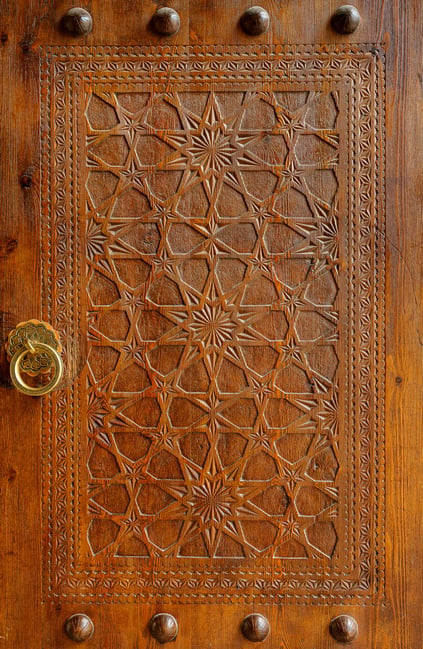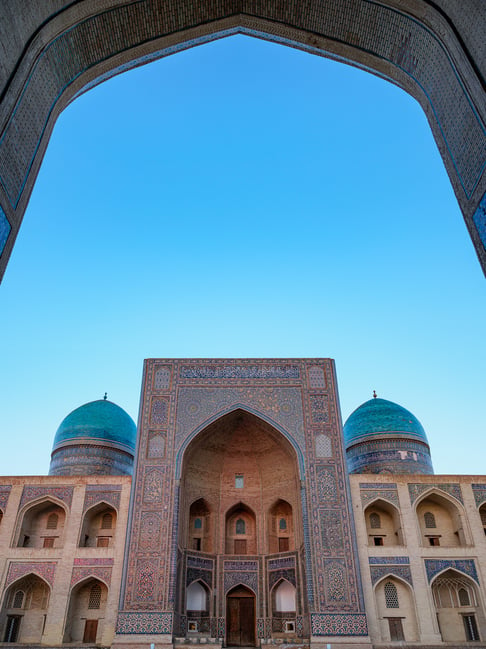The city of Bukhara is another historical marvel of Uzbekistan. The whole center of the city is part of UNESCO’s World Heritage. Bukhara is more than 2,000 years old, and was considered to be one of the most important and prominent cities on the Silk Road. The city’s architecture and atmosphere are truly unique. Some people say that it provides a sense of authenticity that cannot be seen in other places, and I agree – it truly feels genuine and untouched by time.
Poi Kalon Mosque
The Poi Kalon Mosque, along with the Miri-Arab Madrasah are the two structures that have a very similar prominence as the Registan in Samarkand. The Poi Kalon Mosque is a spectacle on its own, and its 46 meter minaret is arguably the most beautiful one in the world. The minaret is lit up from the bottom to highlight its textures at night, so you should definitely make sure to see it at night!

NIKON Z 7 + NIKKOR Z 24-70mm f/4 S @ 25.5mm, ISO 6400, 1/500, f/4.0
The mosque is particularly beautiful during the blue hour. I was lucky to see some color in the sky right after sunset, and with the golden lights illuminating the minaret, I ended up capturing one of my favorite shots from Bukhara:

Dealing with the crowds was a bit tough, since it is a popular landmark. Luckily, I captured a few shots on my tripod without moving it, so I was able to combine multiple images and get rid of all the people from the final shot.
As you enter the mosque, you will be amazed by all the columns and arches that are present here:

The courtyard of the mosque is equally as impressive, with its beautiful blue tiles and mosaics that shine during the golden hour. Bukhara received a lot of rain right before we arrived, and it flooded some of the areas of the city, including the Poi Kalon mosque. I was able to use puddles of water in my foreground to photograph the visitors:

And when flying my drone, I was able to capture some unique shots, with the pool reflecting the courtyard:

I was also fortunate to receive a special permit to climb the minaret, which allowed me to capture unique images of the mosque, as well as its surroundings at sunrise:

While up on the roof, I was also able to fly my drone and capture the mosque from its rear:

Although lugging heavy gear up 46 meters was not fun (and I did it several times), it provided for unique opportunities to photograph Bukhara. One of my favorite shots from the minaret was capturing the Miri-Arab Madrasah across the street using a wide-angle lens. Stitching this panorama was quite painful, because I had a lot of distortion to deal with in Photoshop. After using the Adaptive Wide Angle tool in Photoshop, I was able to straighten the horizon, as well as the Madrasah in the foreground:

While up there, I was also able to photograph other historical buildings nearby:

The whole area surrounding the mosque and the madrasah is stunning, even if you only shoot from the ground level. Here is the view of the same building as the one in the foreground above, with the mosque right behind me:

While there, don’t forget to check out the stunning hand-made wooden doors of the mosque:

Miri-Arab Madrasah
Right across the mosque is the Miri-Arab Madrasah. Built in the 16th century, the Miri-Arab Madrasah is a striking beauty, thanks to its two large blue domes and its uniquely designed front view. Surprisingly, this madrasah is still an acting religious institution, and it is known to be one of the only religious schools that was allowed to function in Soviet Union.

Since it is an active religious school, access to the madrasah is closed for tourists, so you can only photograph it from the front. While the building is a beauty to photograph on its own, I would recommend to use an ultra-wide angle lens in order to step back and frame the madrasah using the front part of the mosque:

In addition, you can get closer and photograph the details of the madrasah in vertical orientation, which can work out great if you can use a person for scale:

Lastly, take your time, go slow and observe the surroundings – you might get all kinds of unique opportunities here. I was fortunate to witness a local couple dressed in traditional Bukharian clothes, who were probably doing a photo shoot for their wedding:

Chor Minor
Chor Minor stands for “four minarets” when translated from Persian. It was built in 19th century as part of a madrasah, which was sadly destroyed, so this is all that’s left from it.

It is a strikingly beautiful building that is well-known in Bukhara, so it is definitely worth the visit. Unfortunately, the government granted permission for people to build houses around it, and one of the locals built an ugly red house to the left of it, which is very sad. Still, you can take a vertical shot and exclude the house in your frame, or simply move to the left of it and photograph from a side angle, as seen in the image above.
Chor Minor is located in a very nice and peaceful neighborhood, and the locals always welcome tourists with hot tea and refreshments.
Samanid Mausoleum
One of the most impressive buildings in Uzbekistan is the Samanid Mausoleum. Built in the 10th century and located right outside the historic center, it is one of the oldest surviving structures in Uzbekistan, and it is considered to be the oldest funerary building in Central Asia.

Take your time and photograph the building from the outside, as well as the inside (it is open for visitation during the day).
Chor-Bakr Necropolis
The Chor-Bakr necropolis is another must-visit site outside the city center in Bukhara. It is historically significant for Muslim pilgrims, because it was built over the burial place of Abu-Bakr Sayyid, one of the four of Abu-Bakr’s descendants of prophet Muhammad.

It is a very peaceful place and there are quite a few tombs here, scattered all over the relatively large territory of the necropolis. I recommend to take your time and explore the site – there are plenty of photographic opportunities here.

Some of the tombs have beautiful turquoise tiles that are partially destroyed:

You can find all kinds of interesting compositions here, with growing trees and plants in the foreground:

Finally, you can pay a very small fee to explore the rooftop of the mosque, which has beautifully-decorated domes:

The Old City
Finally, make sure to walk the alleys of the old city and explore it by foot. Bukhara has so much to see and experience, that there is no way I can add it all on a single page here. With so many mosques, madrasahs, markets and other historic buildings, I would recommend to spend a minimum of three days in Bukhara alone.

I personally had a ton of fun walking the streets and taking pictures of random details, as well as of the people.

And as you walk the alleys, always pay attention to the woodwork, which is quite unique in its own way.

Like I said, there is lot to see and experience in Bukhara…

Table of Contents